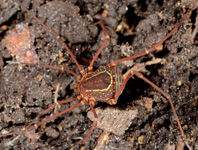Abstract
Two new species of Capezoum: C. tankwakarooensis sp. nov. and C. museiconfluentiarum sp. nov. are described from the Succulent Karoo ecosystem in South Africa and Namibia.
References
Adlbauer, K. (2003) Neue Cerambyciden aus der Äthiopischen Region wie auch taxonomische Bemerkungen bzw. Änderungen (Coleoptera, Cerambycidae, Cerambycinae). Les cahiers Magellanes, 25, 1–15.
Barraclough, T.G., Barclay, M.V.L. & Vogler, A.P. (1998) Species richness: does flower power explain beetle-mania? Current Biology, 8, 843–845.
https://doi.org/10.1016/S0960-9822(07)00527-1Berger, P. (2012) Coleopteres cerambycidae de la faune de france continentale et de corse, Actualisation de l'ouvrage d'André Villiers, 1978. Association Roussillonnaise d’Entomologie, Perpignan, 664 pp.
Buffington, M.L., Burks, R. & McNeil, L. (2005) Advanced techniques for imaging microhymenoptera. American Entomologist, 5, 50–54.
https://doi.org/10.1093/ae/51.1.50Buffington, M.L. & Gates, M. (2009) Advanced imaging techniques II: using a compound microscope for photographing point-mount specimens. American Entomologist, 54, 222–224.
https://doi.org/10.1093/ae/54.4.222Biggs, R., Simons, H., Bakkenes, M., Scholes, R.J., Eickhout, B., Van Vuuren, D., Alkmade, R. (2008) Scenarios of biodiversity loss in Southern Africa in the 21st Century. Global Environmental Change, 18, 296–309.
https://doi.org/10.1016/j.gloenvcha.2008.02.001Born, J., Linder, H.P. & Desmet, P. (2007) The greater Cape Floristic Region. Journal of Biogeography, 34, 147–162.
https://doi.org/10.1111/j.1365-2699.2006.01595.xBrownlie, S., De Villiers, C., Driver, A., Job, N., Von Hase, A. & Maze, K. (2005) Systematic conservation planning in the Cape Floristic region and Succulent Karoo, South Africa : Enabling sound spatial planning and improved environmental assessment. Journal of Environmental Assessment Policy and Management, 7 (2), 201–228.
https://doi.org/10.1142/S1464333205001992Clarke, R.O.S. (2008) Oxylopsebus brachypterus: a new genus and species of Oxycoleini (Coleoptera, Cerambycidae, Cerambycinae) from Bolivia. Papéis Avulsos de Zoologia, 48 (9), 61–67.
Cowling, R.M. & Hilton-Taylor, C. (1999) Plant biogeography, endemism and diversity. In: Dean, W.R.J. & Milton, S.J. (Eds.), The Karoo—Ecological Patterns and Processes. Cambridge University Press, Cambridge, 374 pp. [pp. 42–56]
https://doi.org/10.1017/CBO9780511541988Delahaye, N. (2013) Cerambyx Database. http://www.prioninae.org (accessed 12 June 2018)
Desmet, P. & Cowling, R.M. (2004) Succulent Karoo. In: Mittermeier, R.A., Gil, P.R., Hoffmann, M., Pilgrim, J., Brooks, T., Mittermeier, C.G., Lamoreux, J. & Da Fonseca, G.A.B. (Eds.), Hotspots revisited: earth’s biologically richest and most endangered ecoregions. CEMEX, Mexico, pp. 134–138.
Goldblatt, P. & Manning, J. (2000) Cape plants. A Conspectus of the Cape Flora of South Africa. National Botanica Institute, Pretoria, 731 pp.
Farrell, B.D. (1998) “Inordinate fondness” explained: why are there so many beetles? Science, 281, 553–557.
https://doi.org/10.1126/science.281.5376.555Harris, R.A. (1979) A glossary of surface sculpturing. Occasional papers in entomology, 28, 1–31.
Hilton-Taylor, C. (1996) Patterns and characteristics of the flora of the succulent karoo biome, Southern Africa. In: The biodiversity of African Plants. Kluwer Academic Publishers, Dordrecht, pp. 58–72.
Hovore, F. & Chemsak, J.A. (1980) A review of the Mexican and Central American species of Obrium Dejean (Coleoptera: Cerambycidae). The Coleopterists Society, 34 (1), 31–45.
Kerr, P.H., Fischer, E.M. & Buffington, M.L. (2009) Dome lighting for insect imaging under a microscope. American Entomologist, 54, 198–200.
https://doi.org/10.1093/ae/54.4.198Kuhlmann, M. (2009) Patterns of diversity, endemism and distribution of bees (Insecta: Hymenoptera: Anthophila) in Southern Africa. South African Journal of Botany, 75, 726–738.
https://doi.org/10.1016/j.sajb.2009.06.016Linder, H.P. (2003) The radiation of the Cape Flora, Southern Africa. Biological Review, 78, 597–638.
https://doi.org/10.1017/S1464793103006171Maquart, P.O. & Van Noort, S. (2017) Description of a new species of Capederces (Coleoptera: Cerambycidae; Cerambycinae) from South Africa. Zootaxa, 4244 (4), 583–587.
https://doi.org/10.11646/zootaxa.4244.4.8Mucina, L., Rutherford, M.C. & Powrie, L.W. (2007) Vegetation map of South Africa, Lesotho and Swaziland. 2nd Edition. South African National Biodiversity Institute, Pretoria, 1: 1000000 scale sheet map. [ISBN 978-1-919976-42-6]
Murdoch, W.W., Evans, F.C. & Peterson, C.H. (1972) Diversity and pattern in plants and insects. Ecology, 53 (5), 819–829.
https://doi.org/10.2307/1934297Myers, N., Mittermeier, R.A., Mittermeier, C.G., Fonseca, G.A.B. & Kent, J. (2000) Biodiversity hotspots for conservation priorities. Nature, 403, 853–857.
https://doi.org/10.1038/35002501Olson, D.M. & Dinerstein, E. (2002) The global 200: priority ecoregions for global conservation. Annals of the Missouri Botanical Garden, 89 (2), 199–224.
https://doi.org/10.2307/3298564Quentin, R.M. & Villiers, A. (1969) Révision des Plectogasterini, nov. trib. [Col. Cerambycidae Cerambycinae]. Annales de la Société entomologique de France, New Series, 5 (3), 613–646.
Rutherford, M.C. & Powrie, L.W. (2010) Severely degraded rangeland: implications for plant diversity from a case study in Succulent Karoo, South Africa. Journal of arid environments, 74 (6), 692–701.
https://doi.org/10.1016/j.jaridenv.2009.10.013Rutherford, M.C., Mucina, L. & Powrie, L.W. (2006)Biodiversity and bioregions of Southern Africa. In: Mucina, L. & Rutherford, M.C. (Eds.), The Vegetation of South Africa. Lesotho and Swaziland, South African National Biodiversity Institute, Pretoria, pp. 30–51.
Sala, O.E., Chapin III, F.S., Armesto, J.J., Berlow, E., Bloomfield, J., Dirzo, R., Huber-Sanwald, E., Huenneke, L.F., Jackson, R.B., Kinzig, A., Leemans, R., Lodge, D.M., Mooney, H.A., Oetserheld, M., Poff, N.L., Sykes, M.T., Walker, B.H., Walker, M. & Wall, D.H. (2000) Global biodiversity scenarios for the year 2100. Science, 287, 1770–1774.
https://doi.org/10.1126/science.287.5459.1770Scholes, R.J. & Biggs, R. (2005) A biodiversity intactness index. Nature, 434, 45–49.
https://doi.org/10.1038/nature03289Tavakilian, G. (Author) & Chevillotte, H. (Software) (2017) Titan : base de données internationales sur les Cerambycidae ou Longicornes. Version 3.0. Last Issue: 14/12/2017. Available from: http://titan.gbif.fr (accessed 24 October 2018)
Tolley, K.A., Makokha, J.S., Houniet, D.T., Swart, B.L. & Matthee, C.A. (2009) The potential for predicted climate shifts to impact genetic landscapes of lizards in the South African Cape Floristic region. Molecular Phylogenetic evolution, 51, 120–130.
https://doi.org/10.1016/j.ympev.2008.11.017Zang, K., Lin, S., Ji, Y., Yang, C., Wang, X., Yang, C., Wang, H., Jiang, H., Harrison, R.D. & Yu, D. (2016) Plant diversity accurately predicts insect diversity in two tropical landscapes. Molecular Ecology, 25, 4407–4419.

